Hydrojets and Pop-Pops by DAVID J. WIGGINS
%20[header].jpg)
Hello again. Spring having sprung at last and an old guys thoughts turn to? Well mine turned to the jet and what prompted that was the discovery during my clearout last year of the two vintage items I’m illustrating this month.
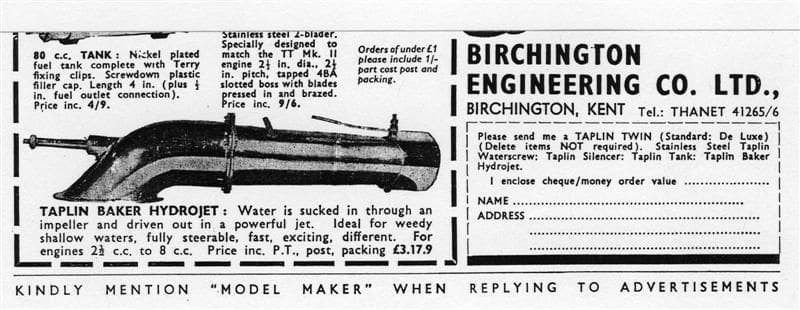
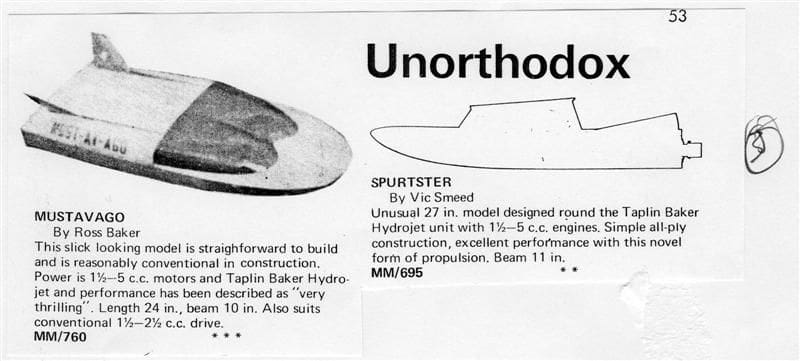
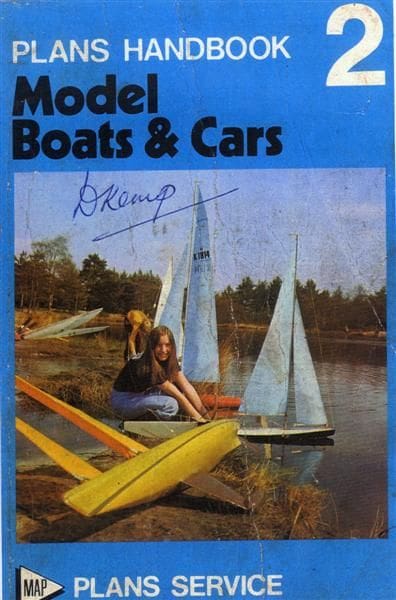
Hydrojets
Enjoy more Model Boats Magazine reading in the monthly magazine.
Click here to subscribe & save.
Not much to look at are they? Well, I disagree. I would not want to have to fabricate either of these two items as both are a long way beyond my metalworking skills. They were both made and indeed small batch mass-produced in a Margate factory way back in the mid-sixties and long before CNC or anything clever like that existed.
Have you CC regulars fallen in yet? What do you think they are? Shown these two objects separately many would I think fail to identify either, but they are the two biggest components of a Taplin-Baker Hydrojet water jet propulsion system made in Margate, Kent by Colonel H.J. Taplins family firm, The Birchington Engineering Co. They were based on an initial design by a New Zealand modeller named Ross Baker, though Taplin completely re-engineered the prototype jet to suit mass production.
The nicely chromed component, done by Taplin family friend Mr Ivor Morgan (who just happened to own a plating works), is finished and ready to assemble and is the main body of the jet. The large oval flanged base, nicely soldered to the tube, was screw fitted to the hull bottom (GRP hulls were much more suited to this than something like a modified Wavemaster or Sea Commander as the keel of any wooden hull is right in the way) via a cork sealing gasket. A conventional 4BA size silver steel propshaft (missing), runs in a short, plain bearing equipped prop-tube and then drives an impeller which is actually a standard 4BA three bladed Ripmax (RMA), nylon propeller of the period.
A friend of mine has suggested that fitting a modern metal three bladed prop. might make for a substantial increase in efficiency at low effort and I think he is very likely correct as the plastic props of the 1960s were certainly nothing special. It was not until Graupner of Germany introduced their hugely popular P and X series red nylon jobbies a decade later that efficiency was improved.
The tapered copper jet efflux tube is an unfinished item, but what lovely work this is. It needs drilling to match the body, then chrome plating and then tightly screwing to it again via a cork or fibre gasket. And there you have it – most of a 1960s jet for a vintage model powerboat.
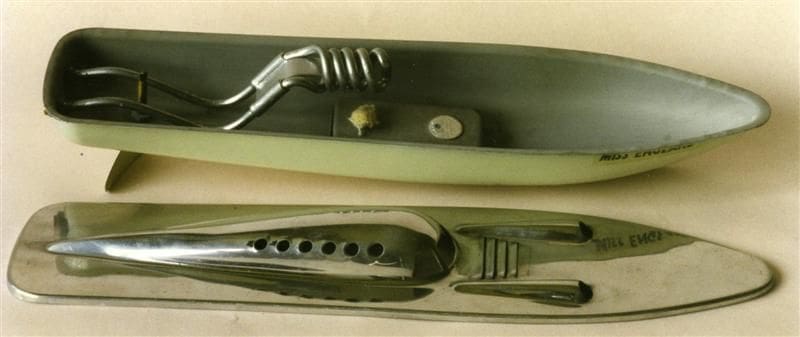
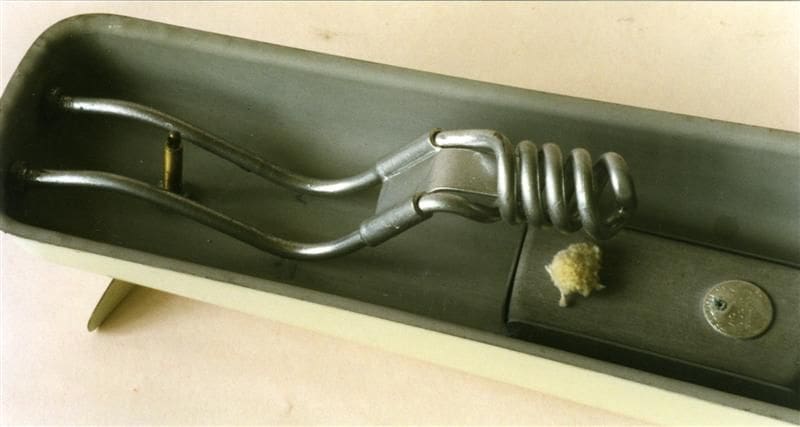
Made in Margate
The 4BA threaded drive shaft can be driven by any decently high revving large model marine diesel of that era, connected up by a standard Taplin universal coupling and Id personally recommend an E.D. 5cc Miles Special or its later derivative – the Viking. The factory naturally recommended their own 8cc Taplin-Twin, but I wouldnt agree with that at all myself, as in my opinion a TT is (a) too slow revving and plodding to give the rapid throughput of water needed, and (b) will quickly wear out the Hydrojets lightweight bearings which just are not up to the high torque of an 8cc in-line twin. A bad bit of design that is most unusual for Birchington products.
The main missing component is the jets nozzle and tiller, without which there is no steering, but making this piece would be no big task and of course there was no reverse on this, at that time, revolutionary unit.
In use, you fired up your engine, primed the jet by dipping it underwater and then let go taking great care not to be directly behind it on release! This was all great fun. A debit side in my opinion and that of many others at the time was poor efficiency, meaning that the same engine on direct drive in the same boat would always prove faster and we proved this ourselvesmany years ago, so its not theory or conjecture. The big upside though, is the ability to run on weedy or shallow waters. These observations are the same with any waterjet propulsion system diesel or electric and old or new. Because of the efficiency question, the Hydrojet was not perhaps Taps Taplins biggest design or sales success, but it was a fun novelty in its time.
These two parts came to me via the late John D. Taplin, Taps elder son, and were amongst the last items to come out of the clearance of the two Taplin factories in Thanet just before he died. They are thus a little bit of boat history that Id not want to see go to waste. Finally, there were one or two boat plans especially for a Taplin Hydrojet, but the choice was never good. Looking back through my old Plans Handbook, I managed to find you two. Mustavago (MM-760), by Ross Baker, originator of our featured waterjet and Spurtster (MM-695) from the always busy drawing board of Vic Smeed, one time Editor of this magazine. These are both specialist designs for a Taplin-Baker Hydrojet.
The Plans Handbook I have is Id guess, a mid 1970s copy. Advertisers included Sanwa (Japanese) and Horizon (British) digital radio gear, Saito steam and OPS i.c. engines. Even then, whoever had edited this had seen fit to add a little footnote near the plans warning that: Hydrojet units are no longer made but quite a few still exist, to justify keeping these two boats in the plans range.
And finishing with a pop!
Im choosing to end with a real jet engine oddity. Some years ago I featured in these pages a really mint pop-pop toy boat made by Victory Industries, courtesy of a friend, Mr. Richard Wrenn.
It may be simple, but like the Taplin Hydrojet, it was a beautifully made toy by any standard. Readers – just look at it – everything, the little spirit tank, the coil, the inlet and efflux tubes and the pressed metal hull are all just perfect, but is it really a jet though? I reckon the answer is that its as much a jet as the Taplin was. Speaking of which I wonder how many Hydrojets there are lurking out there – especially if still in a boat, or even better, in use? Experience of writing CC over the last 17 years or so has taught me anything is possible (as by the way, well see next month).
Speaking of which, next month I would like us to move on from what, whilst called jets, are really just glorified water pumps, to a motor that was just that bit nearer to a real jet engine., so it is Jetex rockets next issue. Until then, its time to say cheerio yet again.
(The plans for Mustavago and Spurtster are still available from the X-Plans list: www.xlistplans.demon.co.uk, @ £9.00 each + p/p Editor)




